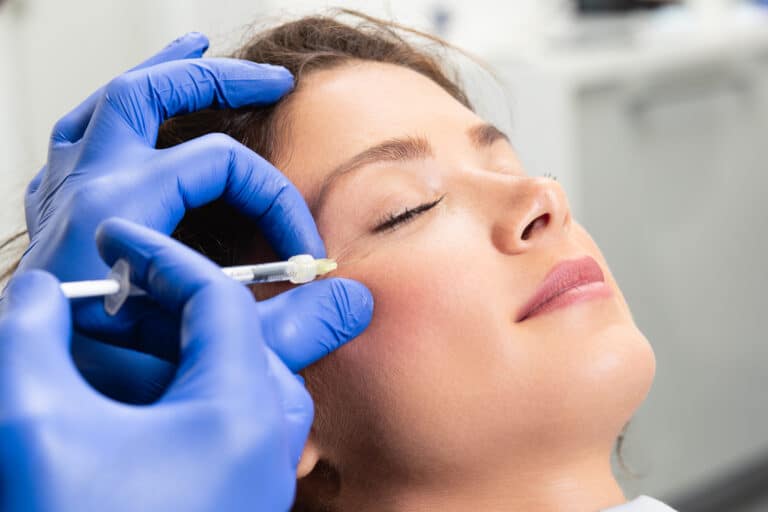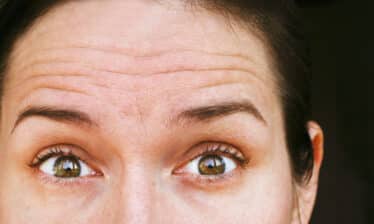Aging is a natural process, and one of the most obvious hallmarks of aging is the appearance of fine lines and wrinkles. Some of the most common locations for wrinkles include the corners of the eyes (crow’s feet), the forehead, and the edges of the mouth.
Still, all is not lost, as the advancement of medicine and technology has made it possible to delay the appearance of wrinkles and slow down the aging process.
There are many ways to do this, including skincare products and cosmetic procedures like Botox and Xeomin injections. If you’ve never heard of Xeomin before, this article introduces what it is, how it works, what it can be used for, how it differs from Botox, and more.
What Is Xeomin?
The bacteria Clostridium botulinum produces a chemical called botulinum toxin. While this substance is deadly in large amounts, it can have many beneficial effects when used in small doses.1
The use of botulinum toxin was first commercialized in the early 2000s as a cosmetic product. Because this is a neurotoxin, it works on the nerves controlling muscle contraction and blocks the nerve signals. This causes temporary muscle relaxation (or paralysis) in the facial muscles responsible for wrinkles. Thus, it has anti-aging effects.2
There are many different types of botulinum toxins. Of these, Xeomin and Botox are two commercial brands that both use the chemical incobotulinumtoxinA as the foundation of their prescription drugs.3
Xeomin vs. Botox: What’s the Difference?
Although Xeomin and Botox are both neuromodulators that work similarly by relaxing muscles and reducing wrinkles, there are still some differences in their formulation, dosing, usage, and functions. These include:4
- Xeomin contains the purified therapeutic component of the protein molecule. Botox, on the other hand, contains additional accessory proteins.
- Because Xeomin contains the active ingredient in a pure state, it doesn’t require refrigeration, whereas Botox injections must be refrigerated for storage.
- Although both are injectables that are generally safe and well-tolerated by patients, Xeomin injectables are at room temperature, so the relatively warmer injections might feel more comfortable to some people than cold Botox injections.
- Because Botox injectables contain accessory proteins, patients may develop antibodies to this product, which may decrease its effectiveness. Conversely, as Xeomin lacks these proteins, there’s no chance of antibody development, and its effectiveness is unlikely to be compromised.
- Both treatments are recommended for reducing the frown lines between the brows. But unlike Xeomin, Botox is also approved for treating crow’s feet and other types of wrinkles.
- Xeomin treatment may show results within a day, so it’s faster than Botox treatment, which usually takes 3 to 5 days to produce improvements.
- The effects of both treatments aren’t permanent and are expected to last for 3 to 5 months, with an average of 4 months.
- Xeomin may be suitable for patients who have developed a tolerance to Botox.
- At some clinics, Xeomin injectables may cost less than Botox injectables.
- Xeomin is a newer product than Botox and is still being tested for several indications.
Thus, Xeomin and Botox are not considered to be replacements for each other and cannot be used interchangeably. They also can’t be used together or at the same time. Make sure to consult your skincare provider to determine which is best suited to your needs.
What Is Xeomin Used For?
The U.S. Food and Drug Administration has approved Xeomin for use in decreasing frown lines (glabellar lines). The dosage for this treatment is 20 units given as 5 injections of 4 units each. Two doses are injected into the eyebrow muscle (corrugator muscle) of each eye, and one dose is injected into the muscle between the eyebrows (procerus muscle). The treatment interval (time between treatment sessions) for frown lines is around 3 months.5
Other medical indications for Xeomin usage include:6
1. Chronic sialorrhea (drooling) in adults or children between the ages of 2 and 17
Dosage: 100 units per session, with 30 units injected into the parotid salivary gland and 20 units injected into the submandibular salivary gland of each side
Treatment interval: 16 weeks
2. Muscle stiffness caused by arm spasticity (excluding cerebral palsy) in adults or children between the ages of 2 and 17
Dosage: 400 units for adults and 200 units (8 units/kg body weight) for children
Treatment interval: 12 weeks
3. Neck spasticity with abnormal head position and painful, involuntary movements
Dosage: 120 units per session
Treatment interval: 12 weeks
4. Blepharospasms (eyelid spasms) in adults with a history of Botox treatment
Dosage: Less than 35 units per eye (70 units total), with usually 1.25 to 2.5 units per injection site
Treatment interval: 12 weeks
The Xeomin treatment result times vary from person to person and may also depend on the individual condition.
What Does the Xeomin Procedure Involve?
Xeomin is administered in injection form. Once your doctor confirms whether Xeomin or Botox is appropriate for you, you can get ready for treatment by avoiding certain medications like blood thinners, aspirin, and anti-inflammatory drugs, as well as food products like ginseng, fish oil, and vitamin E.7
Before starting the procedure, an anesthetic cream may be applied to the treatment area, and it takes around 15 minutes to produce a numbing effect. Small Xeomin doses are then injected shallowly into the target muscles. This is an outpatient procedure with no downtime, so recovery is almost immediate. You may continue your usual work and social routine, but avoid strenuous activity, sun or heat exposure, and places like swimming pools and saunas for a few days after treatment.8
What Are the Side Effects of Xeomin?
Some of the most common side effects of Xeomin usage include:9
- Pain
- Swelling
- Bruising
- Redness
- Itching or hives
- Bleeding
- Headache
- Breathing difficulties (in severe cases)
Some of the side effects observed with sialorrhea include:10
- Dry mouth
- Diarrhea
- Tooth extraction
- Hypertension
Some of the side effects observed with blepharospasm include:11
- Dry eye
- Sagging eyelids
- Vision problems
- Dry mouth
If you notice any side effects after Xeomin treatment, don’t hesitate to seek medical assistance immediately to receive timely treatment.
Final Thoughts
Although there’s no correct answer on whether Botox or Xeomin is better, this post aims to help you gain a better understanding of Xeomin so that you can make an informed decision.
Check out My Filler Treatment today for more interesting information and useful tips on neurotoxins like Xeomin.
SOURCES:
- Good Rx Health: “Xeomin vs. Botox: Which Is the Better Facial Injection?”
- Good Rx Health: “Xeomin vs. Botox: Which Is the Better Facial Injection?”
- Good Rx Health: “Xeomin vs. Botox: Which Is the Better Facial Injection?”
- Boulder Plastic Surgery: “Xeomin or Botox: Which One Is Right for You?”
- Very Well Health: “Xeomin vs. Botox: Which Is Right for You?”
- Very Well Health: “Xeomin vs. Botox: Which Is Right for You?”
- Boulder Plastic Surgery: “Xeomin or Botox: Which One Is Right for You?”
- Boulder Plastic Surgery: “Xeomin or Botox: Which One Is Right for You?”
- Healthline: “What You Need to Know About Xeomin vs. Botox.”
- Very Well Health: “Xeomin vs. Botox: Which Is Right for You?”
- Very Well Health: “Xeomin vs. Botox: Which Is Right for You?”






